Alrosa, Russia’s 1/3 state-owned diamond mining company, has contributed so much money to the Russian navy that this submarine was named after it. Alrosa, which supplies 30% of the world's diamonds, has direct ties to Russia’s nuclear program.
SPECIAL NOTE: After Russia launched its invasion of Ukraine in February 2022, Brilliant Earth announced it would no longer sell Russian diamonds. Yet, the self-proclaimed "global leader of ethical jewelry" had for years been promoting these diamonds as part of their "vision" for the future of the ethical jewelry — despite Russia's previous invasions of Chechnya, annexation of Crimea, attempted extermination of the LGBTQ+ community, and interference in the 2016 US Presidential election. In this article, we’ll break down why things are not always as they seem.
Updated 6/22/2022
Buying from Brilliant Earth is THE WORST choice you could make...if you are interested in “ethical” or “responsible” jewelry that can change the world.
Brilliant Earth may appear to be change-makers like Patagonia, but they are really more like the Monsanto of the jewelry world.
Obviously, this is a bold indictment against the (self-proclaimed) “global leader” in ethically-sourced jewelry. But this is NOT a typical Brilliant Earth review…
This Review vs Other Brilliant Earth Reviews
This is an insider’s analysis full of details you will not find anywhere else, written by two ethical jewelry activists — one of whom even advised Brilliant Earth back in 2006, and has pioneered and tracked the ethical jewelry movement for the past seventeen years. (Our bios are at the end of this piece.)
If you want the essential information to purchase a ring that honors your concerns for ecology, racial and social justice, and the environment, this Brilliant Earth review is for you.
Best of all: reading this Brilliant Earth review will empower you to cut through Brilliant Earth’s “ethical jewelry” spin —as well as the spin on any other so-called “ethical" jeweler’s website.
Our Brilliant Earth Review contains seven parts:
Part 1: Who is Brilliant Earth? Illuminating their methodology to control the market narrative.
Part 2: My 2007 interview with a Brilliant Earth co-founder — and, a definition of ethical jewelry based on moral veracity.
Part 3: A detailed look at the gold supply chain, and the recycled gold greenwashing hoax.
Part 4: How certification systems function as a cover-up.
Part 5: How Brilliant Earth's marketing term "fair trade gold" is deceptive and undermines the broader Fairtrade and Fairmined Gold movement.
Part 6: Hiding crimes in plain sight: How Brilliant Earth endorses the standards of the mainstream jewelry sector, designed to maintain the status quo.
Part 7: Where Black African lives don't matter to jewelers: spinning the "conflict free diamond" narrative.
Each of these sections stands alone. You can jump around as you please, but together they create one coherent argument.
At the end, we provide you valuable links to selected articles gathered from our thousands of hours of research.
Brilliant Earth Review Part One: Brilliant Methods To Shape Your Views
Brilliant Earth was founded 2005 — and in September 2021, the company went public on Nasdaq, raising $115 million. Before the IPO, the company was owned by private equity fund Mainsail Partners III, along with its founders. Brilliant Earth had sales in the first half of 2021 of $163 million. They have 15 showrooms across major US markets, and over 300 employees.
The two founders, graduates of Stanford Business School, saw a blue-sky opportunity in the ethical jewelry movement. With VC funding, over the years they grew to dominate internet searches related to ethics + wedding rings, engagement rings, and/or diamonds.
They claimed — accurately, at least from a market-dominance perspective — that the ethical/responsible jewelry movement was “their” movement.
We, as concerned consumers, just need to trust them and “join” in — as this screenshot shows:

Screenshot taken summer 2018.
To trust has been easy, because Brilliant Earth’s marketing spoke powerfully to the emerging “conscious” consumer market.
It also paved the way for narratives adopted by the 1100-plus members of the Responsible Jewelry Council (RJC), a certification/trade association broadly denounced by a wide swath of social and environmental justice watchdogs — and of which Brilliant Earth is an important member.
We’ll explore this in great detail in Part Six — but for now, here’s the key:
A company as dominant as Brilliant Earth — unless they are a visionary committed to real change (such as Patagonia) — must rely on mainstream supply chains. BUT: these supply chains are controlled by the very companies which have committed countless atrocities for which the jewelry industry is well known.
Just consider two of their main diamond trading partners, De Beers and Alrosa. De Beers diamonds funded wars that killed 3.7 million people in Africa.
Alrosa, a Russian diamond mining company one third owned by the Russian government and run by CEO Sergei Sergeevich Ivanov — one of the Russian oligarchs currently targeted by US sanctions.
Brilliant Earth claims that they are “working hard to increase access to diamonds that are mined in alignment with fair trade principles”...yet the diamonds they have sold from Alrosa for years helped to fund Putin's army killing Ukrainians.
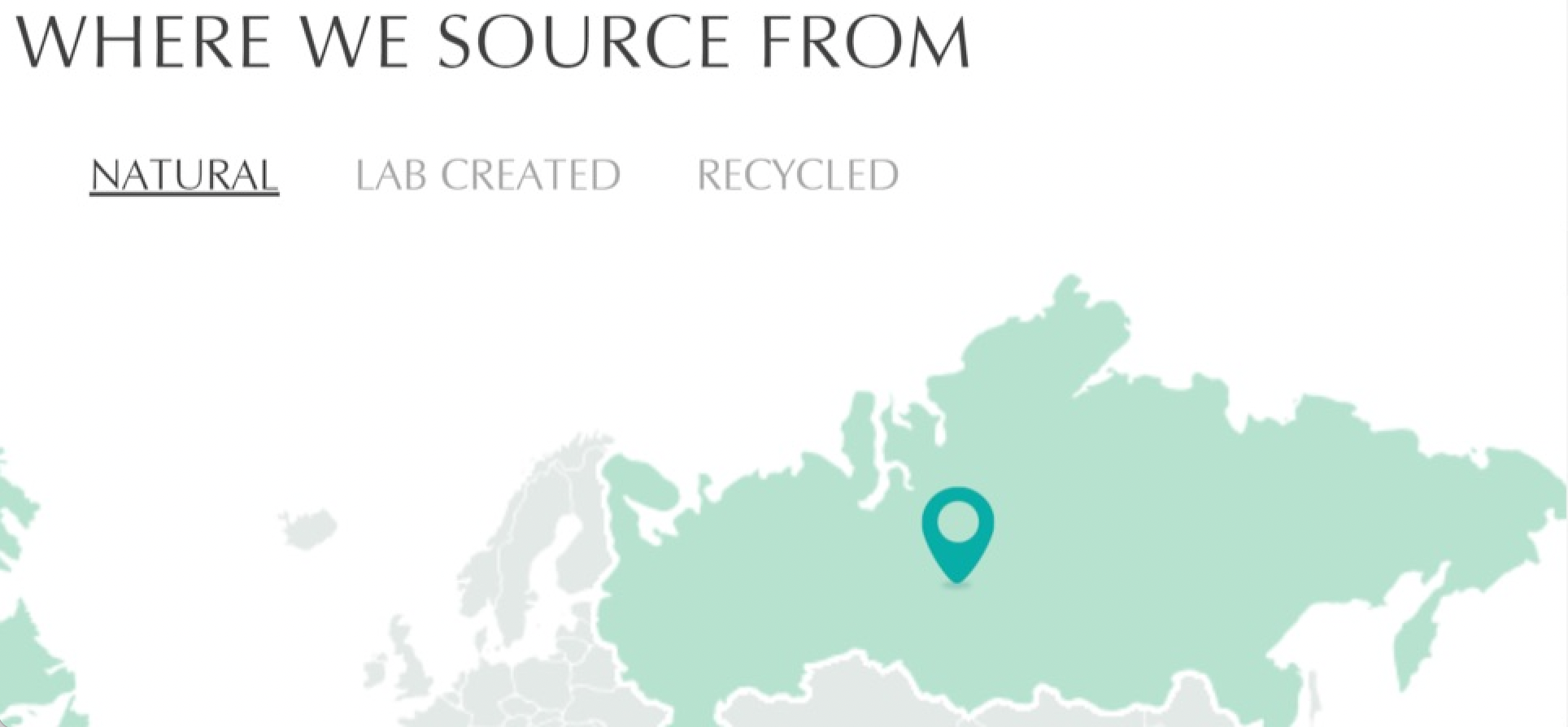
Update: Brilliant Earth has taken this down as of 2/28/22.
The Russian government owns a third of Alrosa. Yet the diamonds from Alrosa, where Brilliant Earth has been sourcing for years — are "Beyond Conflict Free." Russian annexed Crimea in 2014, destroying a country and committing countless attrocities. Where was all the discussion about Alrosa's diamond's being sold as "Beyond Conflict Free" back then?
Ivanov's father, Sergei Borisovich, was a KGB Colonel General, formerly Minister of Defense, and Putin's Chief of Staff. Just given this fact, why would you ever trust this company's claim around ethical sourcing?
Signet, Tiffany, and sixty other firms have relied upon Alrosa as a major source--even through Alrosa extracts uranium and has a business partnership with the company that creates Russians nuclear weapons. Jewelry sourcing has always funded wars and destroyed ecosystems. This critique is not the reality of those companies.
The issue here is that Briliant Earth claims, the global ethical jewelry leader, claims to be different from other mainstream jewelers. And, in fact, they are.
Essentially, Brilliant Earth has cleverly pioneered and collaborated in supporting the current consumer-facing ethical/responsible jewelry story while sourcing much their material from the same supply chain as other mainstream jewelers.
They do this in two ways:
First: they work in concert with the mainstream heavyweights — who have gathered together under the banner of the RJC. The RJC’s website, dedicated to promoting their standards, is akin to a Russian Matryoshka doll: layers upon layers hiding an essential truth: that they function as a trade association for the largest retail and mining companies in the jewelry world: De Beers, Tiffany, Signet, etc. The Russian diamond mining company Alrosa was elected vice chair of the RJC board in May, 2018.
The RJC is all about creating narratives around the ethics of their supply chain to meet the current market. The method is to rebrand the supply chain as ethical and while bypassing past social and environmental attrocities and maintaining the (decidedly less than ethical) status quo. In this manner, they protect their members’ assets and reputations and continue to do business just as they have for decades.
We drill down into this issue with numerous examples in our Ethical Jewelry Exposé, but for now, let's just look at Rio Tinto, another founding member — who can blow up 46,000-year-old sacred Aboriginal caves and still maintain their “responsible” certification.
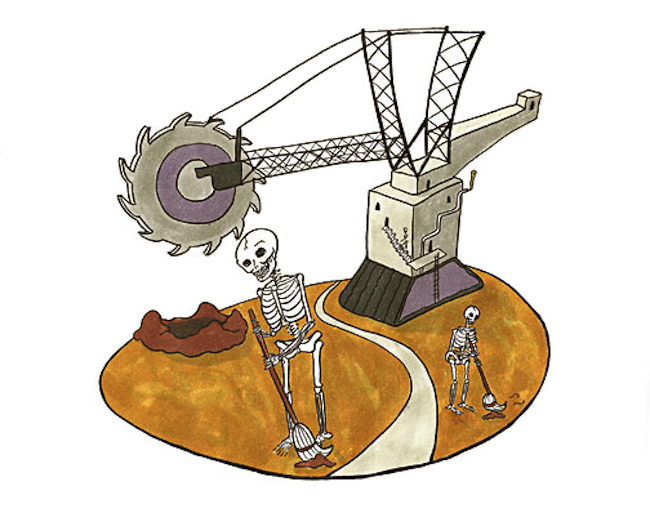
Another point of criticism: the Responsible Jewellery Council's Grandfather Clause implemented in 2012 allowed members to “grandfather” in existing material.
Second: Brilliant Earth creates clever marketing narratives that assure you you can trust them.
Let’s return again to diamonds and take the keystone of jewelry marketing: the term “conflict free diamonds” and we can understand how their selling diamonds from The Russian Alrosa being labeled as "beyond conflict free" is part of a ongoing narrative rooted in the coverup of wars funded by diamonds that killed millions of people.
Any superficially-informed jewelry or engagement ring buyer quickly discovers that the Kimberley Process, upon which the “conflict free diamonds” system is based, has no veracity.
Brilliant Earth, to gain your trust, offers you the assurance that they are “beyond conflict free.”
Really? Not one person in the jewelry sector was held accountable for 3.7 million people killed in wars funded by the diamond trade. There has never been any restitution to impacted communities.
But, by ignoring this, you can be “beyond” it!
Our view is this: An ethical jewelry movement that does not face past and ongoing atrocities perpetuated and supported by large-scale mining and retail companies (such as Brilliant Earth) is bullshit.
Ergo, the ethical jewelry movement, with few exceptions, is bullshit. Or, maybe more accurately, a new version of the same old story.
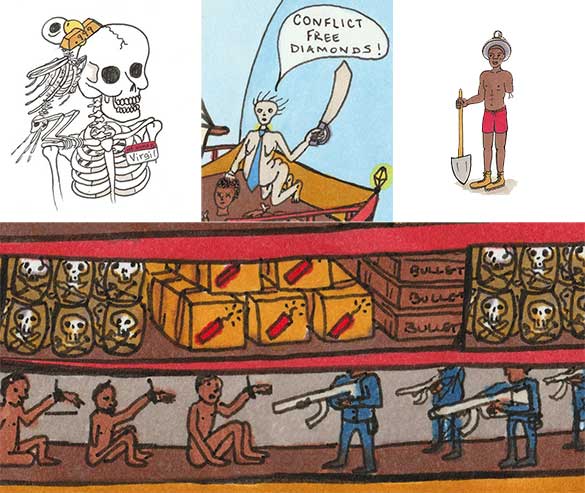
Illustration from our Ethical Jewelry Exposé: Lies, Damn Lies and Conflict Free Diamonds. The jewelry supply chain has not changed much over the past several decades — merely rebranded itself as ethical.
Ethical jewelry is, for the most part based upon, as Ta-Nehisi Coates wrote, “…strange and powerful belief that if you stab a Black person 10 times, the bleeding stops and the healing begins the moment the assailant drops the knife.” There is this sense that if we ignore the issue, and don’t look, it will go away.
The term, “conflict free diamonds” is an extremely convenient cover-up — which is why jewelers love it. It’s all about sell, sell, sell.
Brilliant Earth’s notion of being “beyond” doubles down on and legitimizes the utterly reprehensible “conflict free” narrative, reframing and making it perfectly delicious to customers most concerned about social and racial justice.
But it gets even worse.
Winner Take All
Anand Giridharadas, in his bestselling book Winners Take All, argues that those with power and money and market dominance are NOT going to be leaders in changing the structures on which they built their power.
Yet to succeed, they must create the appearance of being on the right side — so that we may “Join the Movement”!
Brilliant Earth is brilliant in how they use charitable initiatives to show how much they care. From donating to the NAACP to their most recent collaboration with Pure Earth, or even Brilliant Earth’s upcoming tiny (relative to their recycled gold total sales) Fairmined collection, their giving back initiatives have zero impact on the mainstream supply chain.
With few exceptions, the collaboration between many of the NGOs and large-scale retail companies over the past fifteen years have had negligible impact for small-scale producers. Instead: NGOs get their money and bragging rights for working with big companies, corporations get their publicity, and product never reaches the market in a manner that creates any real change in consumer behavior.
Additionally: Brilliant Earth has spent years finding clever ways to undermine legitimate efforts to economic structures by co-opting the language of the real change makers.
For many years, as I show in Part Five, Brilliant Earth has offered clickbait using terms such as fair trade and Fairmined.
Here's an example from 09/2/21:

Brilliant Earth for many years has used terms such as fair trade and Fairmined as click bait.
Real Fairtrade (one word) Gold jewelry is certified by FLOCert. It’s a transformative, powerful initiative that could transform impoverished producer communities.
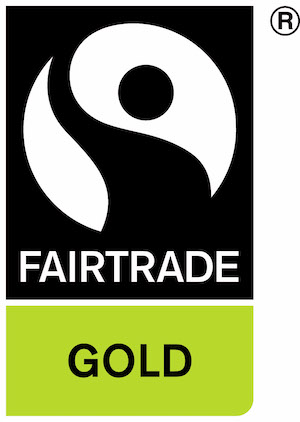
If you haven’t seen this symbol before, we are not surprised. In North America, there are just two certified Fairtrade Gold jewelers. In the UK, where there are over 300 Fairtrade Gold jewelers, it's common knowledge that recycled gold is just rebranded dirty gold.
Fair wages and support for the small-scale mining sector is critical for any systemic change — which even Brilliant Earth agreed to, as we will explore in this next section.
Part 2: Brilliant Earth's 2007 Interview

Eric Grossberg, co-Founder of Brilliant Earth. Photo (cropped here from the original photo in the interview provided by Grossberg.
Back in 2007, I initiated the very first blog on ethical jewelry issues: Fairjewelry Action. One of the first interviews was with Eric Grossberg.
I had met Grossberg at events and had actually consulted with him pro bono on ethical sourcing issues. In the interview, he stated:
“Right now is a real opportunity for us to pro-actively redefine our relationship with the communities from which we source the materials in our products. This should extend beyond whitewashing and doing the minimum to satisfy critical NGOs.”
Thirteen years later, to “redefine our relationship” with producer communities is still the central issue.
"Ethical jewelry" in context to sourcing material should first and foremost be about people of the land controlling and benefitting from the resources of their land. There also should be traceability and transparency, and certification based upon fair trade ideals, as I outline in my feature article, What Makes EthicalJewellery Ethical in Canada's top jewelry trade magazine.
Here’s why:
Over one hundred million small-scale miners produce about 20% of the world’s gold and diamonds. Their lives are typically characterized by extreme poverty, ecocide, and exploitation.
These communities need our market support to create regenerative local economy. That's the opportunity real Grossberg is talking about in the quote above!
Putting economic power in the hands of those digging with shovels begins to address structural issues. As MLK said, "True compassion is more than flinging coins to the beggar; it comes to seeing that an edifice which produces beggars needs restructuring."
In fact, the ethical jewelry movement in the US was birthed because NGOs exposed the plight of the small-scale miner — which certainly resulted in the 2006 release of the film Blood Diamond. Blood diamonds purchased from small-scale diamond miners funded wars in the ‘80s and ‘90s that killed 3.7 million people.
At that time, in 2007, I was showing our jewelry in the Designer section of JCK in Vegas, North America’s premier wholesale event. Advocating for fair trade practices back then, buyers looked at me as if I were a lunatic.
These days, ethical jewelry has become the hot trend in the jewelry marketing. Every jeweler is, to some degree or another, branding themselves as “responsible” or “ethical” trying to capture socially concerned Millennials and Z's.
Let’s now explore how Grossberg, whose company has been central in defining the ethical jewelry market narrative, has, to use his words, taken the, "opportunity for us to pro-actively redefine our relationship with the communities..."
We start by looking at the foundational material in jewelry: gold.
Part 3: The Gold Supply Chain: A Situation Briefing
The first thing you need to know is that newly mined gold comes from two sources: large-scale mining or small-scale mining.
Large-scale gold mining is one of the most nefarious of all industrial activities. It supplies about 80% of the world's gold, and much of that gold ends up in bank vaults. We should oppose it.
Small-scale mining can be equally damaging, but it is about the politics of bread vs. the politics of greed.
Take a look at this video I shot in Tanzania a few years ago:
This miner is hand-mixing mercury, gold dust, and water. Small-scale mining is the greatest contributor of global mercury contamination. He will end up with a small nugget looking like this — a gold and mercury amalgam:
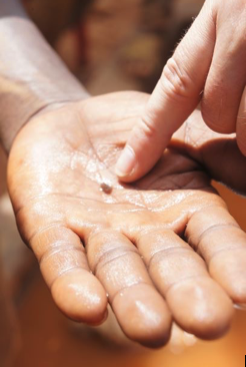
Gold fused with mercury after the panning shown in the video above. I took this photo.
He will take the mercury and gold amalgam and cook it in his frying pan before dinner, poisoning himself and his environment with methyl mercury, one of the most dangerous neurotoxins known to man.
He will later sell this gold for about 30% under market value. That’s barely enough to live on, so he remains stuck in a cycle of poverty.
This process destroys the ecology of entire regions, and the effects will last for hundreds of years.
These are the people who supply who make up 90% of the world’s gold mining labor. They mine to survive.
The good news is, we, through the Fairtrade Gold initiative, can transform this nefarious situation into a local economic development that eliminates mercury contamination and environmental destruction while uplifting people out of poverty.
In fact, in the UK, Fairtrade Gold was recognized as a major market trend back in 2017 and even grew 30% in 2019. There are over 250 Fairtrade Gold jewelers in the UK alone. Full disclosure here: I started making jewelry from Fairtrade Gold in 2011, and have been the only certified Fairtrade Gold jeweler in the US since April 2015.
But here's a critical point I want to emphasize:
The foundation of ethical jewelry practices in the UK and the EU is based on sourcing from the impoverished small-scale communities throughout the world.
Let’s now, in our Brilliant Earth review, consider Brilliant Earth's interface with the opportunity to support arguably the most transformative ethical sourcing initiative available for jewelers: Fairtrade/Fairmined Gold.
A Review of Brilliant Earth's Fairmined Gold "Temporary Promotion" And Recycled Gold Story
Fairmined/Fairtrade Gold was introduced to the UK in 2011, though the standards split in 2013. These days we have Fairtrade Gold and Fairmined Gold.
Though Fairmined and Fairtrade Gold are different brands with different politics, what’s critical to understand at this point is that both would help the guy above extract gold safely, removing mercury from the environment while uplifting the miner from desperate poverty.
Also, both Fairtrade Gold and Fairmined Gold have failed to have any significant market impact in the US.
Brilliant Earth, the “leading ethical jewelers,” jumped on the Fairmined Gold initiative in 2013 and endorsed it strongly.
Note this screenshot, taken in the summer of 2018, from Mining in Latin America: Critical Approaches to the New Extraction, which elaborates on Brilliant Earth’s strong commitment to the Fairmined Gold movement:

And here, another screenshot taken around the same time off Brilliant Earth's website of the Fairmined Gold mines Brilliant Earth sources from:
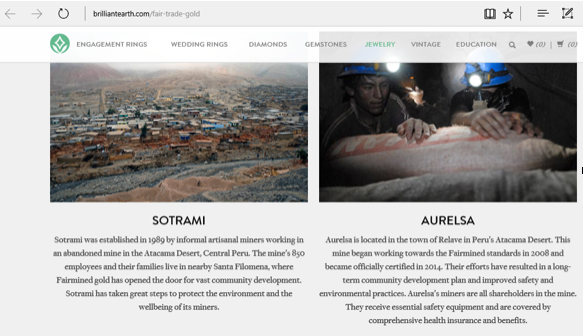
Note above the URL on this page: It isn’t “/Fairmined-gold.” It’s /fair-trade-gold, which is a much stronger keyword even though Brilliant Earth does not sell Fairtrade Gold.
This statement below about making a positive difference through Fairmined Gold remains on their website as of September 2020:
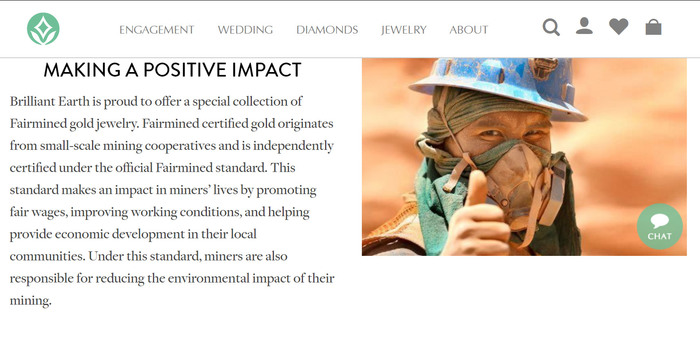
The problem is, Brilliant Earth is marketing Fairmined Gold even though they phased it out by 2018.
This screenshot, taken spring of 2018 (and still up in September 2020), shows the full extent of Brilliant Earth’s Fairmined Gold product listings:
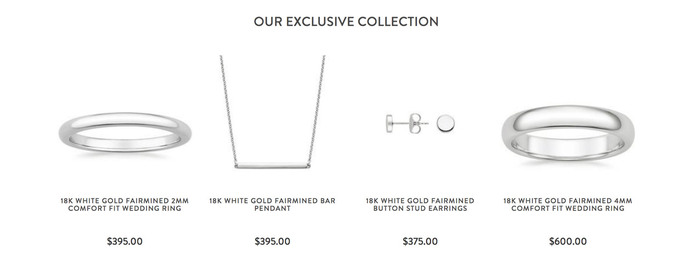
By June of 2018, only one of the items pictured above — the ring on the far left — was actually still for sale. As of December 2019, it no longer was.
We inquired to Brilliant Earth about the necklace above and got this email back:
“I spoke to my team about our fair minded (sic) gold collection and it was just a temporary promotion we did…. Our fair-mined collection was for a limited time in limited styles. Both Fairmined and recycled are very ethical supply chains. We like working with recycled metals because then there is no new mining that takes place and then we are not causing any more environmental degradation.”
So…in Brilliant Earth’s own words, their commitment to Fairmined Gold — one of the most transformative powers in uplifting small-scale miners from poverty — was “just a temporary promotion.” So temporary and inconsequential, apparently, that their own team member spelled "Fairmined" fair minded.
Here’s what’s key:
Once someone lands on one of Brilliant Earth’s Fairmined Gold pages, they are led to recycled gold. A Brilliant Earth customer representative says, “both Fairmined and recycled gold are very ethical supply chains.”
However, they are far from equal.
Creating a market that has the potential to uplifts millions of small-scale gold miners...is not the same as purchasing recycled gold from one of dozens of refining companies.
Here is one of the most important key points in my Brilliant Earth Review:
Any gold, including recycled gold which we cannot trace back to source, should be considered dirty gold.
The fact of the matter is, we do not know the origin of any recycled gold. Certification traces it back only to the gold refining company which melts it down. Then, the gold is sold back to the jewelry manufacturing company where it is rebranded as an “eco-friendly” recycled gold ring.
This illustration below, the same as the one at the start of the article, shows what's really going on:
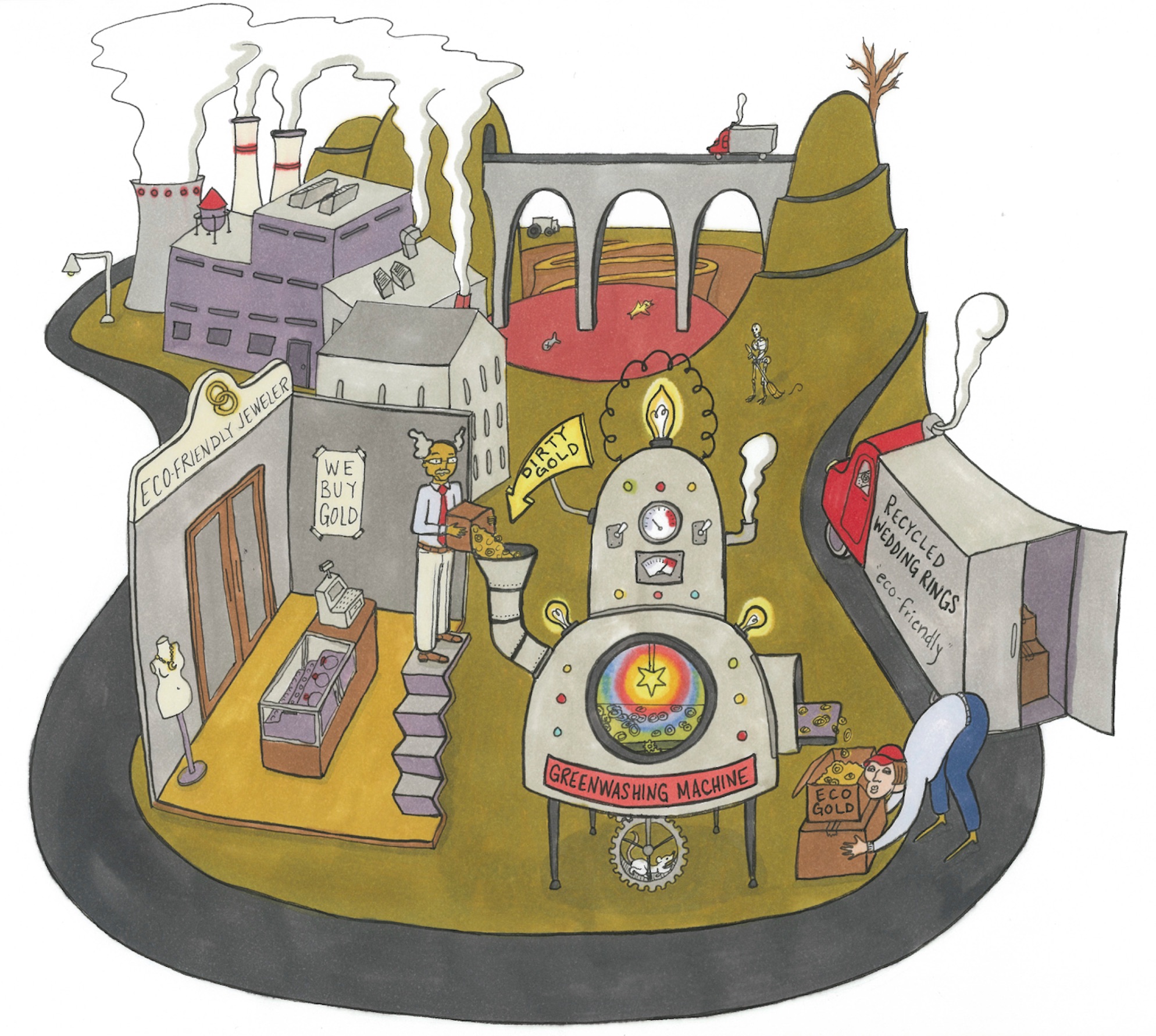
Incredulity is stretched from even further with the advocacy for recycled gold as a deterrent to mining, as shown in this screenshot from their website in June 2018:
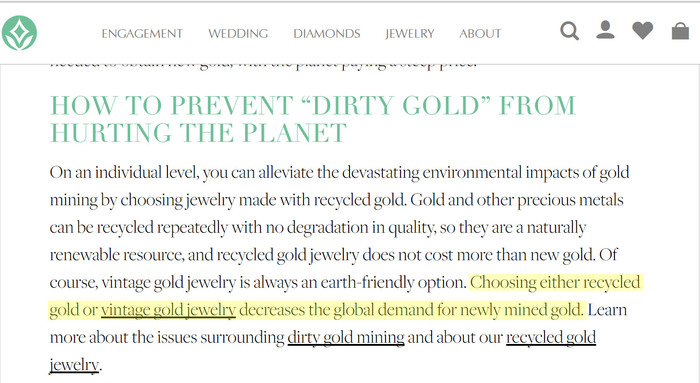
Recycled products have a great consumer perception. Recycled paper reduces cutting down trees. Recycled aluminum means less aluminum demand for beer cans. All of this is true.
Because anything recycled has such a powerful appeal, almost all consumers will believe buying recycled gold helps to save the planet!
But, obviously, gold is a currency hedge!
With gold prices approaching $2000 an ounce, large-scale mines will continue to destroy the environment with massive industrial holes in the earth as long as they can make money doing so. This is about greed. I oppose large-scale gold mining and have led campaigns against it in my community.
Small-scale mining is different. It will continue as long as the miners need to feed themselves and their families. It too will massively expand as the price of gold rises with global instability due to COVID-19.
Here's my key point:
There is no evidence anywhere that choosing recycled or vintage gold has any impact on global demand newly mined gold.
Update, February 2022:
Brilliant Earth recently announced an upcoming collection of jewelry to be made with Eco Fairmined Gold, as part of a partnership with the NGO Pure Earth.
Precisely how much gold will be sourced, how many miners will benefit, and how many products will be offered in Fairmined Gold remains to be seen. However, these authors have serious doubts that this is anything more than a marketing scheme, designed to maintain Brilliant Earth's pristine image without impacting their bottom line.
If you've read this far into this piece, you may understand our view that what matters is not symbolically "flinging a coin to a beggar," but engaging in the real work it takes to "restructure edifices" — to paraphrase MLK.
With this in mind, let's continue our deep dive:
Part 4: Brilliant Earth Review of "Certified" Recycled Metal
Brilliant Earth uses a third-party organization, Scientific Certification Systems (SGS) Global Services, to certify their recycled precious metal, as explained in this article from 2017.
Below is a screen shot of SGS’s website taken in 2018:

What exactly does “certified recycled gold” mean? It means certification is about tracing metal back to a refiner. Not back to the mine
Buying gold from refiners is easy. A “gold refiners” Google search reveals dozens of potential sources.
But here’s what you need to know:
There’s no way of knowing whether or not the CERTIFIED “eco-friendly” RECYCLED gold you are choosing to wear on your finger to represent your marriage was originally taken from the teeth of Holocaust victims or the Mt. Polley mine, a dagger in the heart of First Nation communities — a topic I explored in a conversation Chief Bev Sellers of the Soda Creek Band in this recent interview.
Certification only traces it back only to the gold refining company which melts it down. Then, the gold is sold back to the jewelry manufacturing company where it is rebranded as “eco-friendly."
It would be one thing if Brilliant Earth merely advocated for recycled metals and left Fairtrade and Fairmined initiatives alone, but that's not the case.
They play to dominate in a Winners Take All paradigm.
Part 5: Review of Brilliant Earth's Marketing of Fair Trade and Fairmined Gold
Even though Brilliant Earth has not sold Fairmined jewelry for a while, they continue to market it as this screen shot from November 2019 shows:
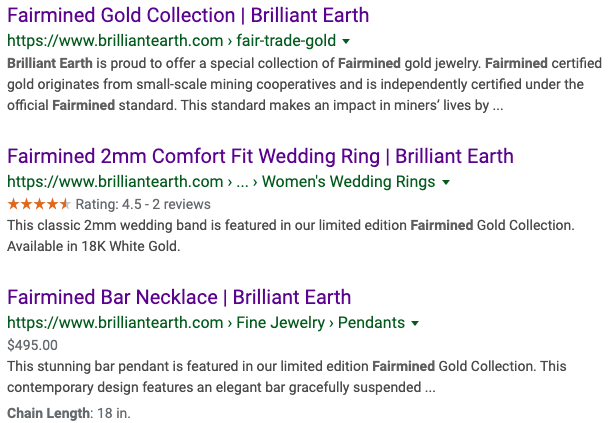
People click on this link bait and find themselves on the Brilliant Earth website.
Though Fairmined Gold has not gotten any market traction in the US, there are still a few small jewelry studios who use it.
But because of Brilliant Earth’s dominance on Google, those looking for Fairmined Gold will land on highly ranked Brilliant Earth pages. From there, they will be encouraged to buy recycled gold (which a customer service rep explained is essentially equal in ethics to Fairmined Gold.)
This practice not only enhances Brilliant Earth’s business, but it also creates market confusion, undermining smaller studios who have tried to make a real difference for producer communities
Here’s the kicker: what Brilliant Earth does is even worse than using Fairmined clickbait.
Brilliant Earth’s marketing, its powerful emphasis on recycled metals, also impacts a viable Fairtrade Gold movement.
Review of Brilliant Earth's Fair Trade Gold and Fair Trade Jewelry Claims
Fairtrade Gold is perhaps the most powerful transformative product in the jewelry world today. It is popular in the UK and several EU countries.
Recycled gold as an ethical proposition would never be taken seriously in the UK, where Fairtrade Gold is the market choice. As I mentioned above, there are over 250 Fairtrade Gold jewelers in the UK.
In the US as well, those looking for exceptional ethical jewelry might well search for the keyword “fair trade + gold."
But before we go further, let’s start by defining fair trade as “a social movement whose stated goal is to help producers in developing countries achieve better trading conditions.”
“Fairtrade” and “fair trade” are not the same thing.
In brief: the term “Fairtrade Gold” is trademarked by FLO/Fairtrade International. The Fairtrade logo is one of the most powerful global brands:
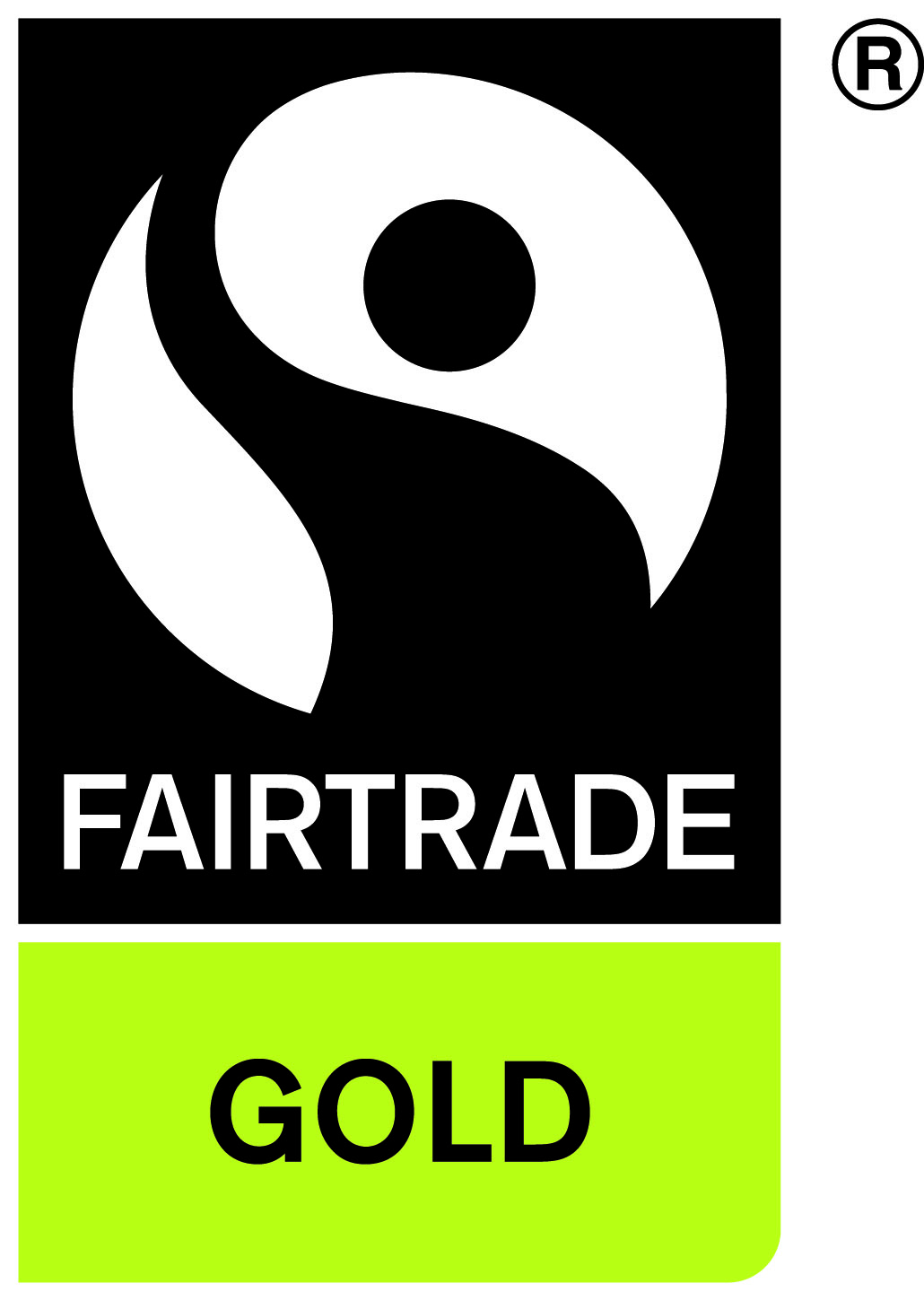
You’ve probably seen this logo (without the “Gold”) on chocolate or coffee. I am the only jeweler in the US who can use it.
“Fair trade” is a general term that can be used by anyone, in any context. This makes it a magnet for false claims, akin to the words “all-natural,” which food conglomerates love to spin.
The point is this:
The general consumer in the US looking for a wedding ring does not understand the difference between "Fairtrade" and "fair trade."
Let’s take a review of how Brilliant Earth exploits this situation, marketing the search term “fair trade." This Google screenshot is from the summer of 2018:
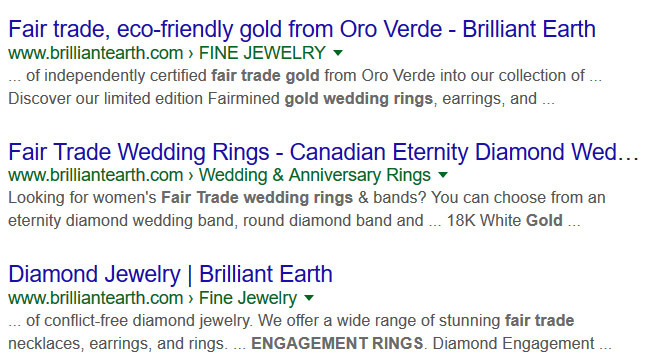
Another example: the screenshot from November, 2019, implies in its title: "fair trade gold - Brilliant Earth" that Brilliant Earth sells fair trade gold.

Additionally, these two screenshots below state that “Brilliant Earth promotes the development of a fair trade gold system” as part of “Our Movement.”
The first screen shot is from August 2018, and the second was taken in November 2019.


Essentially, there is no such thing as this “fair trade gold system.” To make this claim confuses the market narrative and undermines the real Fairtrade Gold initiative.
If you want to understand why, check out this video I took of Tina Mwasha when I was visiting mines attempting to get Fairtade certification in Tanzania. She is Tanzania's first woman mineral processing engineer:
Take a moment and imagine the power to do good that Brilliant Earth might have achieved if they went with Fairtrade gold instead of recycled gold. The process is really difficult, as I explain here. But Brilliant Earth could have done it.
Regardless, this general confusion among many between the terms "Fairtrade Gold,” which a trademarked term audited by FLOCert, and “fair trade gold,” which has no real universally-accepted standards and principles, ends up spreading into very authoritative sources.
For example, this Wikipedia article seen in a November 2019 Google search states that Brilliant Earth has committed itself to using “fair-trade-certified gold”:

Again, I just want to emphasize that these claims sabotage not only the Fairtrade Gold movement, but all other efforts to support the quintessential link between so-called “ethical” / “responsible” / “eco-friendly” jewelry sourcing and impoverished, exploited producer communities — the guy mixing his hands in mercury.
Brilliant Earth’s nefarious fair trade gold wedding rings marketing strategy continues into the present. Here’s a screen shot from July 23rd, 2021:

I could end my article here, and leave you to judge for yourself whether, in consideration of this Brilliant Earth review, this company's practices align with your personal values.
But it gets even worse. We still have not arrived perhaps the most brilliant strategy of all...
Part 6: Review of Brilliant Earth's Alignment With The Responsible Jewellery Council
Let us go back to the beginning, when co-Founder Eric Grossberg mentioned in his quote that he wanted to go “beyond whitewashing and doing the minimum to satisfy critical NGOs.”
Let's take another look at how this plays out.
A bit of background info first:
The Responsible Jewellery Council is a nonprofit founded by fourteen companies in 2004. Among those fourteen are De Beers, Rio Tinto, BHP Billiton, Cartier, Newmont Mining, Signet Group, Tiffany & Co, Zales Corp, and Jewelers of America. Today, the Council has over 1200 members and represent hundreds of billions of dollars of retail and mining interests.
Brilliant Earth is a member of the Responsible Jewellery Council, yet the very NGOs that Brilliant Earth endorses as a way to tell you how much they are concerned about human rights and environmental atrocities denounce the Council's standards.
Here's how that works:
Non-Governmental Organizations (NGOs) have acted as key watchdogs for the jewelry sector. From Global Witness’ first exposure of the Blood Diamond wars in 1998, to Earthworks’ important No Dirty Gold Campaign in 2004, to the more recent work of Human Rights Watch’s “Beyond the Bling” in 2018, and many others.
Brilliant Earth has long marketed their relationship with NGOs to boost their credibility — such as in this article referencing Amnesty International.

These articles are mainly critical of a wide variety of social and ecological justice issues regarding the sourcing from the mainstream jewelry sector.
And, the organization that best represents the “responsible” methods of the mainstream is the Responsible Jewellery Council.
It is the Council which has created a set of “responsible” standards which are currently being widely adopted across the industry based upon “chain of custody protocols.”
As shown in the screenshot below, Brilliant Earth is a member of the Responsible Jewellery Council:
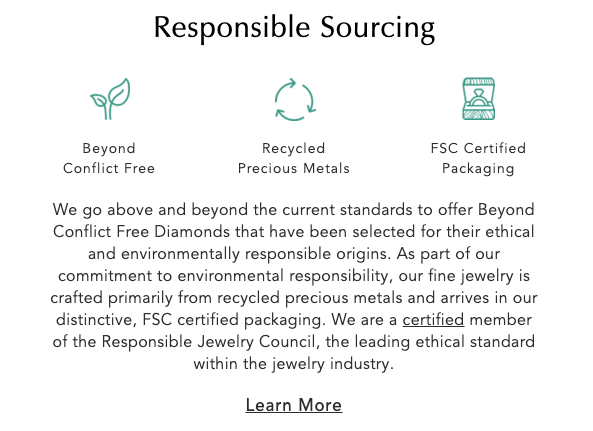
Screenshot taken September 2020.
Now, stay with me.
Understanding these matters is a little bit like opening Russian dolls. You think you have arrived in the center, but that’s merely one more layer that covers up what is in the actual core.
So, let me connect some dots as to why this endorsement is significant:
Earthworks, the NGO that started the No Dirty Gold Campaign back in 2004, published a brutal and substantive critique of the Responsible Jewellery Council’s credibility in their 2013 white paper: More Shine Than Substance.
To quote from the executive summary:
“The Responsible Jewellery Council system and its components are riddled with flaws and loopholes… rendering it an ineffective tool by which to create an environmentally and socially responsible supply chain in the jewelry industry.”
Yet Brilliant Earth uses the credibility of Earthworks to promote their ethical stance, particularly their commitment to Earthworks’ powerful No Dirty Gold campaign.
A Google search containing Brilliant Earth and No Dirty Gold will yield numerous articles. Additionally, here is a screenshot from Earthwork’s website, from November 2019:

This screenshot below shows Brilliant Earth referencing a Human Rights Watch article. The article on blood diamonds and violence in Africa, based upon information from Human Rights Watch, shows to the average person that Brilliant Earth considers this NGO an important watchdog for the jewelry sector.

Screenshot from November 2019.
Yet…in context to the Responsible Jewellery Council’s “responsible” standards," the 2018 Human Rights Watch report, The Hidden Cost of Jewelry, wrote,
“The Responsible Jewellery Council promotes standards that allow companies to be certified even when they fail to support basic human rights… (it) is essentially an industry body. Its decision-making bodies do not include consumer groups, representatives of mining communities (for example, organizations addressing land rights or environmental harms), trade unions or miners’ associations, or human rights nongovernmental organizations (NGOs).”
Moreover, Human Rights Watch’s anti-Responsible Jewellery Council call to action was signed by these 29 NGOs:
Amnesty International, Anti-Corruption Trust of Southern Africa, ask! Arbeitsgruppe Schweiz Kolumbien (Swiss Working Group on Colombia), Artisanal Gold Council (Canada), Centre for Natural Resource Governance (Zimbabwe), Child Labor Coalition (US), Coalition de la Société Civile de la Région de Grands Lacs contre l'exploitation illégale des Ressources Naturelles (African Great Lakes Region), Ecumenical Institute for Labor Education and Research (Philippines), Enough Project (US), Gesellschaft für bedrohte Völker (Society for Threatened Peoples STP, Switzerland), Global March Against Child Labor, Global Witness,Groupe d'Appui aux Exploitants des Ressources Naturelles (Democratic Republic of Congo), Groupe de Recherche et de Plaidoyer sur les Industries Extractives (Côte d’Ivoire), Human Rights Watch, India Committee of the Netherlands (Netherlands), IMPACT (Canada), IndustriALL Global Union, International Corporate Accountability Roundtable, International Labor Rights Forum, MIHOSO International (Ghana), National Consumers League (US), New Light Children Centre Organization (Tanzania), Public Eye (Switzerland), Réseau de Lutte Contre La Faim (Cameroon), Solidarity Organisation Afrikagrupperna (The Africa Groups of Sweden), Stop Child Labour Coalition (Netherlands), Swedwatch (Sweden), Zimbabwe Environmental Law Association (Zimbabwe).
Let me give you one more example of Brilliant Earth referencing their concern and support of NGOs — this time, in context to diamonds.
In 2011, Global Witness, the organization that uncovered the blood diamond atrocities, resigned from the Kimberley Process Certification Scheme, which ostensibly works to prevent conflict diamonds from entering the market.
The issue was over Zimbabwe diamonds. Essentially, blood diamonds from Zimbabwe were being certified by the Kimberley Process as Conflict Free.
Brilliant Earth references Global Witness numerous times in articles, but here are a few examples spotted in November 2019:
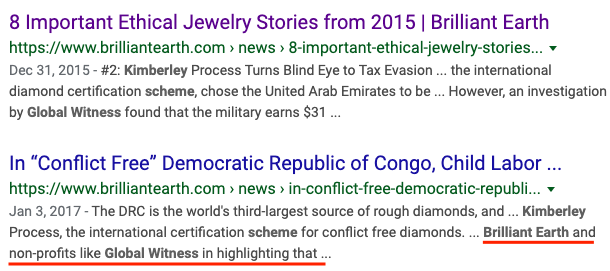
Note the text at the bottom: "Brilliant Earth and non-profits like Global Witness in highlighting….” This is a kind of co-branding. We’re led to believe that that Brilliant Earth is strongly aligned with champions of human rights.
Yet, the Responsible Jewellery Council endorsed blood diamonds coming from Zimbabwe as Kimberley-certified “conflict free" back in 2009. This was the event that many industry insiders considered fatal to the Kimberley Process.
At that time, Global Witness (who exposed the blood diamond attrocity to the public) dropped out of the Kimberley Process, stating that its decision to accept Zimbabwe diamonds had “turned an international conflict prevention mechanism into a cynical corporate accreditation scheme.”
Do you see the contradiction?
Brilliant Earth rejects the validity of the Kimberley Certification Process yet endorse the Council which has unconditionally supported Kimberley.
Here's the bottom line:
Brilliant Earth reviews that do not consider the implication of that endorsement of the Responsible Jewellery Council's standards are inherently flawed, because people choose Brilliant Earth over a company like Blue Nile because of their ethical stance.
But what I've mentioned in context to the Council gets even worse. Just one more brief bit of information and then we can go on the the final section.
In 2012, the Council published this declaration:
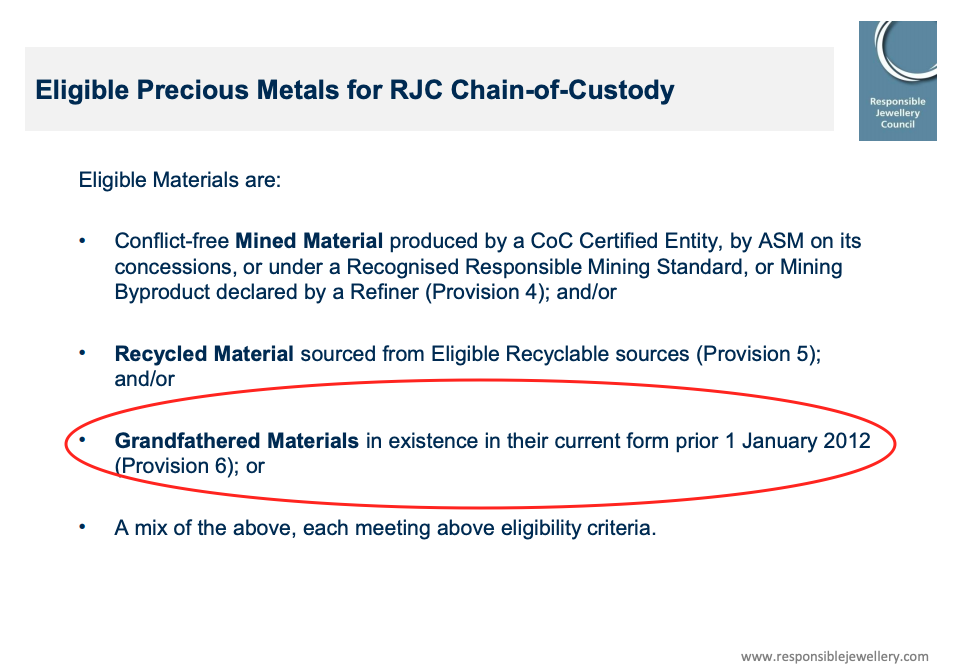
The Council essentially bypasses any historical atrocity, whether it be the diamond wars that killed 3.7 million people when De Beers controlled almost all the diamond trade, or more recent acts.
This is a systemic issue among Council members. Follow the links to these companies: Anglo Gold, BHP Billiton, Newmont, Rio Tinto; all now producing certified “responsible” gold under the Responsible Jewellery Council’s code.
Here are the key points, in summary...
Any Brilliant Earth review must take into account that they support and endorse a Responsible Jewellery Council which allows its members to deny previous atrocities.
This standard, according to the NGOs that Brilliant Earth like to reference in their articles to show how much they care, “fails to support basic human rights” as Human Rights Watch states. The Council even supports a system that allows blood diamonds from Zimbabwe to be called “conflict free.”
This is all part of a brilliant strategy.
Support of the Responsible Jewellery Council means that you gain support of the trade and the trade press. This garners massive positive publicity and access to resources. I just want to emphasize that this is a huge PR benefit.
Initially, back in 2007, the mainstream jewelry trade saw Brilliant Earth as a potential threat. Now, the recycled gold approach has been fully embraced by the trade. Here's Stuller, the largest jewelry supplier, with its recycled gold narrative.
Yet Brilliant Earth also can appeal to the ethically-minded consumer aligned with the views of Earthworks, Human Rights Watch, and Global WItness.
This is a perfect razor’s edge to ride: they get a whole spectrum of support: mainstream press, trade press, progressive ethical jewelry/fashion blogger press.
And when you buy from them, you too can Join the Movement!
Part 7: Diamonds, Brilliant Earth Reviews, And The "Beyond Conflict Free" Narrative
Any consideration of Brilliant Earth would be incomplete without considering diamonds, which comprise about half of all jewelry sales.
Before I get into the the heart of this issue, the New York Times writes here that diamonds can cost 12% TO 20% on Briliant Earth than smaller retailers and then there's tale of a Brilliant Earth scam from the pricescope community.
Also, in 2017, Jacob Worth posted a detailed journalistic exposé on YouTube that traced a diamond Brilliant Earth claimed was Canadian back to the vendor. That vendor said on tape the diamonds were not Canadian origin. The video created quite a stur, even in the mainstream jewelry trade press. Brilliant Earth sued and Worth removed the video.
Worth's compelling argument is still online, documented in Bryan Clark article in The Next Web and Philip DeFranco’s YouTube video.
Though these critics raise important issues around Brilliant Earth's sourcing, the focus in this section of my Brilliant Earth review is the marketing of diamonds through the "Beyond Conflict Free" label.
To start, let's take note of the coherence in Brilliant Earth's marketing. In section three, we explored the strong linage to fair trade. Fair trade, as I described earlier, has a great halo effect. It shows the progressive, concerned consumer that they are stiving for human rights and environmental justice.
The screenshot below taken in August 2018 conveys how Brilliant Earth is on the forefront of making fair trade diamonds a reality. They are among the stakeholders involved in discussions!

Here’s what’s key:
There were no discussions at the time I posted this screenshot.
Greg Valerio, the father of the Fairtrade Gold movement, who worked for Fairtrade International, confirmed in a 2018 conversation with Fairtrade International that Brilliant Earth is not in any kind of discussion with them over “fair trade” diamonds.
And yet, in Reuters article explains that the founders of Brilliant Earth, who were interviewed, are, "collaboring on an initiative to create the world's first Fairtrade diamonds in Sierra Leone." (Italics mine.) Note again, Fairtrade = FLO Cert. FLO Cert has NOT been involved with the DDI.
My understanding is that, at this point, diamonds are not even on Fairtrade’s radar.
Yet in Brilliant Earth's marketing, they claim to sell “fair trade diamonds" — a product that does not exist! Note: "Fair trade" as two words. Legal to use, but essentially as meaningless as the word, "natural" in the term, "natural chicken."

Screenshot from spring 2018.
Further: on their website, Brilliant Earth claims that they are “working hard to increase access to diamonds that are mined in alignment with fair trade principles...”
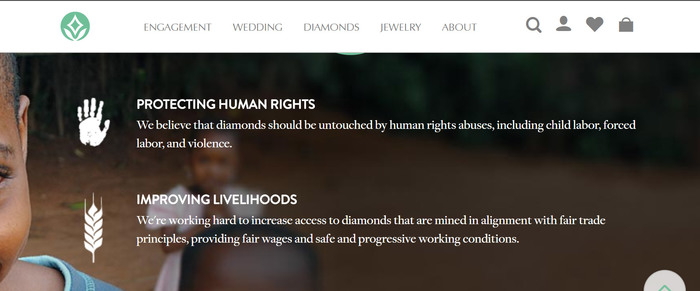
Screenshot from spring 2018.
Where do these fair trade or fair trade principled-diamonds come from?
Brilliant Earth sources from Responsible Jewellery Council members, such as Rio Tinto (Canada) and De Beers (Botswana and Namibia), though it's revealing that I couldn't find De Beers specifically referenced as a source.
Brilliant Earth’s sourcing of diamonds also includes Russia:
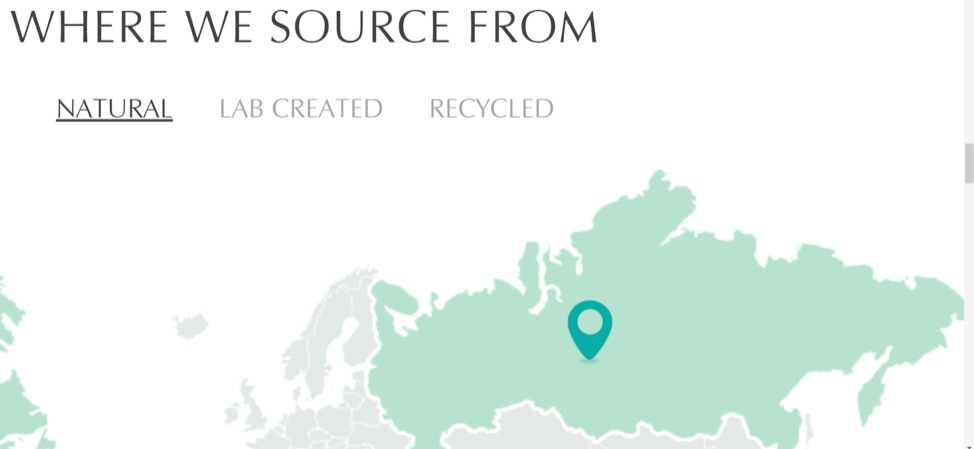
Screenshot from Brilliant Earth’s website showing diamond sourcing at the Alrosa mine in Russia.
Alrosa was referenced in this New York Times article in context to corruption allegations and Brexit. The largest buyer of this rough material has been Lev Leviev, notorious for his human rights abuses in Angola. The Russian government (Putin) also has a significant share in Alrosa.
In context to a fair trade diamond, Brilliant Earth does help fund the Diamond Development Initiative. This Initiative was mentioned in the screenshot just above, where I referenced "discussions."
The Diamond Develoment Initiative is part of Brilliant Earth's "vision" for a fair trade diamond future, as shown in this screenshot off their website:
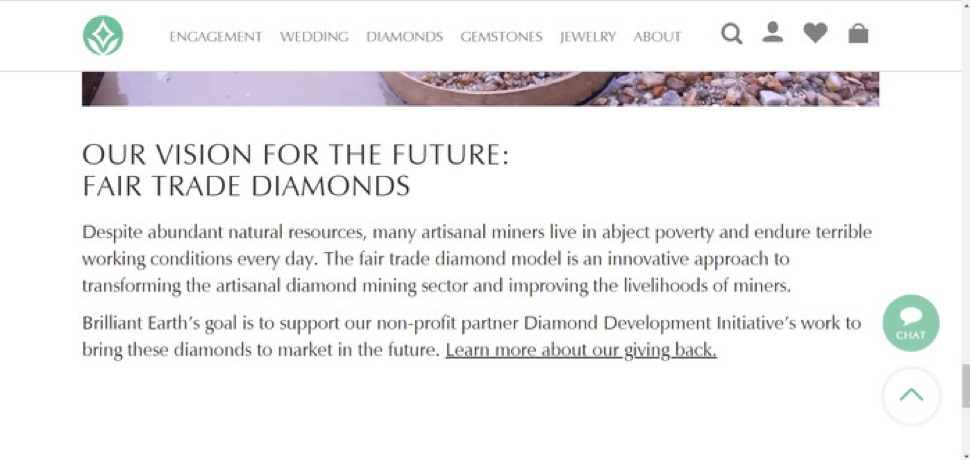
Screenshot from August, 2018.
The Diamond Development Initiative (DDI) started back in 2008, aspiring to be aligned with Fairtade Intentional. They have operated since then, funded by large mining and retail jewelry companies.
Since its founding, I've followed the DDI's progress. A fair trade diamond would be transformative to the jewelry industry.
Now, as of 2021, the Diamond Development Initiative has operated for 13 YEARS(!!!) without bringing one diamond to market under any kind of "fair trade" label. Why?
It's true that civil society institutions in Sierra Leone are weak. The miners have to be convinced that there is something in it for them than what they have now and it takes a lot of time to build trust. . Also, Lebanese mafia control much of Sierra Leone's diamond purchasing.
Yet diamonds from this project have been exported and sold into the market.
Why can't we have a DDI diamond now?
De Beers is the only distributor of DDI diamonds. Even though, as of the fall of 2021, they are beginning to sell parcels of the DDI diamonds under the Gemfields labe, they do not want diamonds from this project to go on to the market labeled in a manner that would compete with their current narratives.
And, they are notoriously secretive about their practices. In this interview from November 2020 with Ian Smillie, ED of the Diamond Development Initiative and one of the framers of the Kimberley Certification Process, I learned that we do not even know how many diamonds are being produced by the DDI.
Here's the bottom line:
Perhaps the greatest reason the jewelry sector loves the DDI is that it is a great symbol that can be bragged about. Yet it will never be a threat to their status quo, because it is totally unscalable.
The global CSR report on De Beer's "sustainable solutions" states, "The company believes it is important to support ethical practices across the whole diamond mining industry, so by 2030 they will deliver scalable solutions to improve the livelihoods of artisanal miners."
Sure, by 2030, they are going to figure it out! As for sustainability:
De Beers is up to their old tricks — dumping waste in Canadian First Nations Communities. Mathew Galvin Frank explores in this piece on legacy De Beers mines in Africa how environmental destruction is forever.
De Beers has more expertise in mining diamonds in Africa than all other diamond companies combined. Yet I can help but feel, given the history, having De Beers in primary control of a potential fair trade diamond supply chain is analogous to making the American neo-Nazi and former KKK leader David Duke head of the Southern Poverty Law Center.
Reviewing Brilliant Earth's "Beyond Conflict Free" Diamonds
Because the Kimberley Process, which certifies diamonds as conflict free, is essentially broken, Brilliant Earth and ethical jewelers have to create new narratives in order to show that they are watching out for concerned consumers.
every jeweler sells their diamonds as "conflict free." But the conflict free narrative has been attacked because of the weaknesses in the Kimberley Certification Process.
Brilliant Earth claims to be “Beyond” the notion of “conflict free,” which basically conveys that they are extraordinarily careful (i.e. mines only partially owned by Putin's govenment) about their diamond sourcing, as described below:
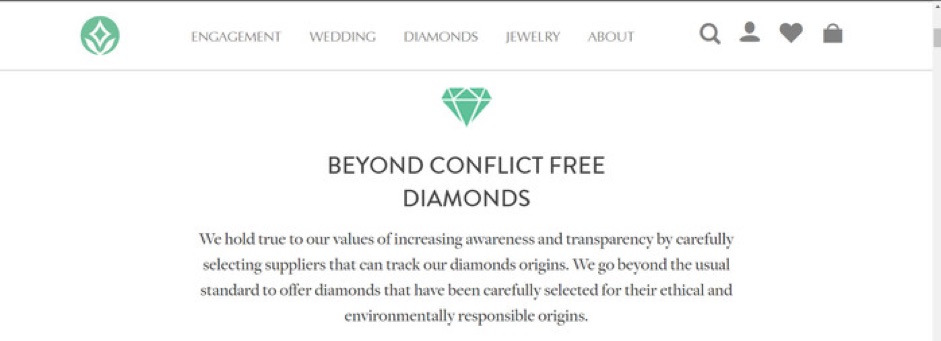
Screenshot from summer 2018.
I’m not going to detail my personal abhorrence of the "conflict free" narrative. I have written about it widely. I am the only jeweler in the world, as far as I know, who argues we should Boycott Conflict Free Diamonds.
So, I’ll give you the quick version of how a feel, a bit of my editorial opinion:
Kill 3.7 million Africans in the eighties and ninties and then invent a “conflict free” narrative without truth, reconciliation, or restitution, to cover up the crimes. No one. NOT ONE JEWELER or DIAMOND DEALER has been held accountable for those killings.
De Beers controlled about 85% of the diamond supply chain when blood diamond wars were taking place. De Beers is a major trading partner with Brilliant Earth.
To me, “conflict free diamonds” = black African lives don’t matter. The term should be torn down like statues of confederate generals.
“Beyond” conflict free diamonds doubly affirms a narrative that ignore past attrocities and hides crimes in plain sight.
Kind of reminds me of the Hannah Arendt term “banality of evil.”
What’s Your Brilliant Earth Review?
Since my initial involvement in ethical Jewelry sourcing — as a jeweler named “The Best of the Best” in 2019, a writer on these issues for major trade magazines and other conscious consumer publications, I have watched a movement grow from nothing to the most important market trend.
It would seem, from the popularity of ethical jewelry sourcing that the sourcing of jewelry has changed. Certainly, you might get that from bloggers, trade press, and other Brilliant Earth reviews.
But, instead of creating an ethical jewelry movement in North America that would focus on small-scale producers who most need support to create regenerative local economic models…
Instead of basing participation in such a movement from large multinational mining companies on truth, reconciliation, and restitution to the communities impacted…
What we have are forward-facing narratives that hide crimes in plain sight, by companies that want to capture this new market through specious narratives with a supply chain that draws minimally, in context to gold and diamonds, from exploited small scale miners.
High-profile charity initiatives can easily become a way of masking a new version of an old colonial story:

So, based upon what I’ve written here, how would you review Brilliant Earth now?
At the start of this article I asked a simple question: can they be trusted?
My opinion: not only should we not trust them, we should create a consumer boycott of this company until they change.
Please do leave a comment — even a short one helps get this info to more people. The comment section is after the reference sections below.
Suggested Companies Where You Can Find Fairtrade/Fairmined jewelry and gemstones.
There are numerous Fairtrade Gold jewelers in the UK that are reputable and which you find on Google.
In the US, my company, Reflective Jewelry, which hosts this article, is a custom designer studio of five people. We are the only Fairtrade Gold jewelers in the US and can make wedding/engagement ring design in Fairtrade Gold.
I also recommend Toby Pomeroy. They have tried harder to create a Fairmined Gold market than any other US jeweler.
Stay away from any jeweler that cannot offer Fairtrade/Fairmined and instead only pitches eco-friendly responsible recycled metals.
For gemstones, I highly recommend Columbia Gem House. They have pioneered fair trade gems. Your jeweler can purchase the stone of your choice directly from them. Also, there’s Moyo Gems and RubyFair.
For natural diamonds, if you are trying to sort out what kind of diamond to purchase, I wrote this article which covers the pros and cons of natural vs. lab grown diamonds, and what's available in the market.
In sum, I would recommend Canadian sourced, which your jeweler should be able to provide for you. For lab grown, I recommend our source, which is the Diamond Foundry. They are certified carbon neutral.
Links for Additional Reading and Research:
On Dec 3rd, 2020, we published in Canada's top trade magazine perhaps the most important article on ethical jewelry sourcing you'll read anywhere: Where Black Lives Don't Matter to Jewelers
Additional features published in that same magazine will give you a broad understanding of what’s going on right now. The first is What Makes Ethical Jewelry Ethical? The second is A Dream Deferred, Ethical Gold in North America. Finally, The Responsible Jewellery Council's big narrative is around "sustainability." My piece, The Sustainability Trap, outlines how "sustainability" in the jewelry world is destroying our future.
For years, my view about recycled metal was far outside mainstream. But in 2021 the times are changing! The mainstream jewelry sector is catching on to the recycled gold deception. Here's an interesting piece by Robb Bates, of the jewelry trades top insider writers, describing ethics around recycled gold as "eco theater."
I gave a to this piece above, but here it is again. An astonishing, must-read "smoking gun" article in the NY Times from Aug. 22, 2000, Controvsy Over Blood Diamonds Made Into A Virtue, describes how the death of millions via blood diamonds was a marketing opportunity. De Beers controlled nearly all of the African supply chain during much of the blood diamond wars.
Millions were killed in blood diamond wars, but did you know that the real victums were not those who were killed and the families left behind, but jewelers? Read about it in Birth of the Ethical Jewelry Movement.
Two more NY Times articles: mercury used in gold mining in Indonesia and the Amazon.
Sometimes I'm asked, how come you are the only Fairtrade jeweler in the US? It makes no sense! To learn more about the politics and the history of Fairmined/Fairtrade Gold in the US, read this.
Read about our Fairtrade Gold initiative here and information on Fairtrade Gold vs. Recycled Gold. The differences between “Fairtrade Gold” and “fair trade gold” are outlined in this piece.
I've done considerable research and writing on the Responsible Jewellery Council. Read this to start. Further, here, the CEO of the “nonprofit” Council admits that the organization is really a trade association! A trade association determining its own standards and acting as a self-certification agency...no conflict of interest there, eh? And, if you really want to dig in, in this piece I provide evidence that their standards are weak and ineffective.
The Kimberley Process is the basis of “conflict free diamonds” claims. To learn more about these issues, read my article on how the Kimberley Process fell apart.
To dig more deeply into De Beers and the Diamond Development Initiative, read Death of the Fairtrade Diamond. Perhaps equally interesting is this piece I wrote in detail here on how jewelers finesse and spin the conflict free diamond narrative.
For the deepest dive into these issues, return to the Ethical Jewelry Exposé: Lies, Damn Lies and Conflict Free Diamonds landing page and start at the beginning!
If you have questions you can contact me via my email: info(at)reflectivejewelry.com.

**All writing and images are open source, under Creative Commons 3.0. Any reproduction of this material must back link to the landing page, here. For high resolution images for publication, contact us at expose(AT)reflectivejewelry.com.**

Kyle Abram has been the Reflective Jewelry Brand Catalyst since 2017. In addition to brand management duties such as SEO and online marketing, his work involves researching, writing on, and otherwise supporting regenerative business models that move the global economy toward racial, social, and environmental justice. Abram is a signatory of 2020’s BIPOC Open Letter to the jewelry industry, has served as a representative for North American jewelers to the USAID Zahabu Safi (Clean Gold) Project, has appeared as a featured speaker at the Chicago Responsible Jewelry Conference, and is involved with Ethical Metalsmiths in multiple capacities: serving an Editor/Author for their blog The Source, and on their Action Coalition. He recently co-authored “Where Black Lives Don’t Matter to Jewelers,” published in Canada’s top trade magazine. In addition, he is an inaugural recipient of the Black in Jewelry Coalition x GIA Distance Education Scholarship, and in training to become a GIA Graduate Gemologist. Abram holds a BA from Brown University in Contemplative Studies. He can be reached at kyle(at)reflectivejewelry.com.
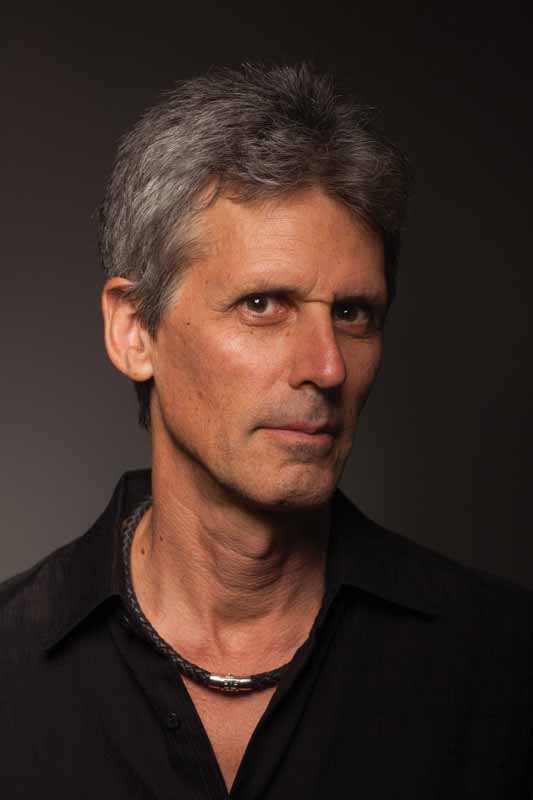
Marc Choyt is president of Reflective Jewelry, a designer jewelry company founded in 1995. He pioneered the ethical sourcing movement in North America and is also the only certified Fairtrade Gold jeweler in the United States. Choyt’s company was named Santa Fe New Mexico’s Green Business of the Year in 2019, and he has been honored with several awards for his efforts to support ethical jewelry. He is a regular feature writer for Canada's top jewelry trade magazine: Jewellery Business. His ebook, Ethical Jewelry Exposé: Lies, Damn Lies and Conflict Free Diamonds, is available online. Choyt holds a BA in Creative Writing from Brown University, and a MA in Classics from St. John's College. He can be reached on Twitter at @Circlemanifesto or by email at marc(at)reflectivejewelry.com.